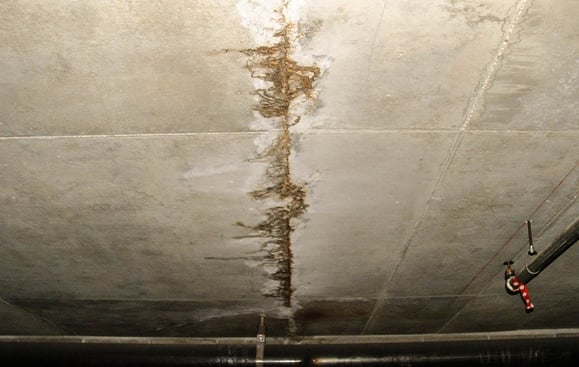Building and construction materials are at risk for water damage from the time they leave the factory to the time the building is weather-proofed, which includes the installation of roofs, wall systems, windows, and doors. Some materials can withstand limited periods of exposure to the weather, but others can become permanently damaged, and become a perfect environment for mold growth.
Understanding which materials are at greater risk for water damage
While some materials such as concrete and steel are generally immune to damage if they get wet, others, including wood studs and beams, plywood, oriented strand board, wallboard, insulation, interior fixtures and furnishings, and some doors and windows are at risk to become damaged and require protection from the elements during construction.
If these materials become moist, some can be dried without any effects, while others end up unusable and/or out of warranty. One main concern of wet materials not being dried properly is the growth of mold. Mold requires warmth, a moisture source, and an organic food source to thrive and spread. If mold forms it may need to be treated and/or removed in accordance with applicable state and federal regulations, industry standards, and/or a professional.
How materials get wet and what can be done to prevent it
Mold in homes usually occurs from one or two sources:
- Water intrusion from the outside through walls, roofs, or windows
- Indoor moisture sources such as leaking water pipes, floods, large or numerous plants, or other water sources like aquariums, and condensation
When moisture intrusion happens at, or near an exterior wall, the mold can grow in the wall cavity and damage the face of the drywall, and the insulation.
Rain is the primary reason materials become wet during construction. Additionally, materials end up wet due to the contractor's inability, or unwillingness to protect the structure. Framing lumber and sheathing, concrete, and rigid insulation can be dried out after short exposures, and usually do so once the weather clears.
However, problems develop when materials, sensitive to water damage are installed, or stored in the building before the roof and walls are completed. A good example of such material is gypsum wallboard used to construct firewalls and elevator shafts. Because the gypsum wallboard needs to be installed at the time of the framing, it is inevitably going to become wet due to rain or condensation. This can lead to permanent damage, and/or, mold forming on the gypsum wallboard.
The protection of installed work and of stored materials from water damage (rain or other sources), can be expensive, and may affect the planning and sequencing of a project, but is nonetheless one of the contractor's primary responsibilities on a project under construction. This includes normal rain or snow events as well as hurricanes, heavy rain, and flooding.
Ways to protect work from water damage include:
- Proper sloping to prevent water from pooling especially on exterior structures such as balconies
- Flashings at key areas of construction such as exterior areas like window and door openings, along with light fixture and piping penetrations and at the intersection of building components such as walls and floors
- Priming of materials, especially wood, to prevent water absorption
- Sealants in addition to flashing and priming
- Temporary protection with tarps and/or heated/conditioned enclosures
Concerns about water damage?
If you believe water damage occurred during construction or are seeing water damage during an active project, CCA can help. Our team of engineers and architects has a wide range of experience with identifying water damage and developing relevant remediation plans. We welcome the chance to speak with you to explain more about how we may help.




